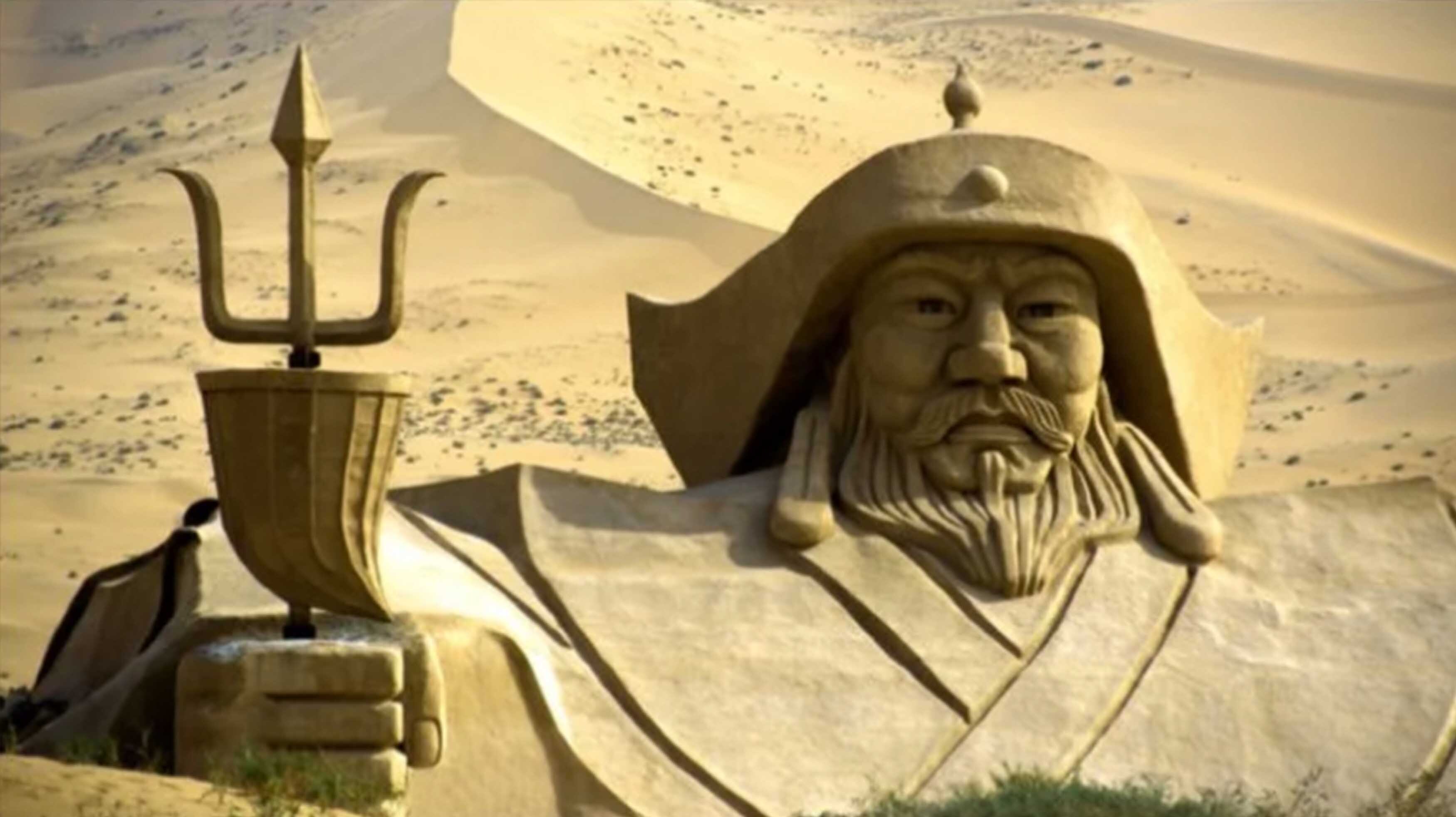Genghis Khan’s Bizarre Burial: Hidden Graves
There’s an ancient legend that Mongolian Ruler Genghis Khan desired that no one ever know the location of his grave, so he sent an army of men to murder anyone who came in contact with the funeral procession. And it gets even more interesting than that! This episode explores the First Khan’s funeral legend, other famous unknown grave sites and then we play with quick quiz with Comedian & Performer Matt Donnelly!

The Mausoleum of Genghis Khan is an ornate blue and white octagonal hall. It’s a top-rated tourist attraction outside of Ordos City in Inner Mongolia, which is an autonomous region landlocked inside of China. As many as 8,000 tourists visit each day to pay tribute to Genghis Khan. The main hall of the mausoleum contains a cenotaph – that’s a fancy word for a burial monument that contains no body. That’s because for 794 years, no one has ever figured out where Genghis Khan was buried.
The Mongolian ruler Genghis Khan was born sometime around 1162 near the Burkhan Khaldun mountain in Mongolia. Now for the purposes of this episode, I’ll be pronouncing his name Genghis Khan – another correct pronunciation is the way it’s pronounced in Mongolia, Chinggis Khan. But for consistency and continuity, we’ll stick with Genghis. To put it into a cliff’s notes version, he was the founder and the first Khan – which is a title meaning emperor of the Mongol Empire. His legacy is being an absolutely brutal conquerer. His armies conquered hundreds of cities and murdered millions of people. In doing so, he created the largest contiguous land Empire in the history of the world – a mass of land equal to around the size of the continent of Africa. Genghis Khan’s Mongol Empire stretched as far West as modern day Poland and as far South as what is now Egypt. While he is remembered for ruthlessness and violence, he was once remembered for spreading culture, science and technology to many parts of the world. His empire was ethnically and racially diverse. He is considered the most successful military conquerer of all time.
The last conquest of Genghis Khan was Yinchuan, the capital of the Western Xia province of China. The Mongols conquered the city and slaughtered it’s entire population in 1227. It’s believed that it was during that battle that Genghis Khan died. No one is certain how he died. Theories range from being killed in battle to falling off his horse to dying from wounds he sustained while hunting – which is a theory that was spread by explorer Marco Polo. A legend that was circulated later was that he was killed by a Western Xia Princess that he had abducted. Some of the versions of that legend are pretty imaginative and not appropriate for this podcast, so I’ll let you look that one up yourself.
The army that the Khan had amassed when he died was more than 129,000 men. So why is it that one of the most famous humans to have walked the Earth has an unknown burial site? The simple answer is he wanted it that way. But the more detailed answer is a story that’s worth hearing.
Quite a few famous people from history have lost, unmarked or unknown graves. Take Mozart. When Mozart was buried, he was buried in a common grave. He wasn’t ultra wealthy and he wasn’t aristocracy, and as such, his grave was subject to excavation after a period of ten years after his death. This was the practice in Vienna at the time as there wasn’t enough room in the cemeteries. After a period of 10 years, the remains were gathered and added together with other interments to consolidate space. Because of this, over the years, the actual remains of Mozart were lost.
Some famous graves have been hidden from the public because if they weren’t, they’d attract too much unwanted attention.
Alexander the Great’s tomb is unknown. After he was entombed, his grave was repeatedly raided and looted. It was moved, but since then sea levels have changed, earthquakes have changed the land, and entire cities have been built over what was once ancient Alexandria.
Atilla the Hun, Cleopatra – many rulers from history have graves that are now lost. But looking at the burials of people closer to our time might help us to understand why some would want their gravesites to be hidden.
The grave of John Belushi became a place for people to party. The family didn’t like this, nor did the cemetery, so he was moved to a quiet hillside cemetery. The family says that his grave marker there doesn’t actually mark the site of his grave, which has been kept a secret.
Nobody knows the location of the gravesite of Steve Jobs. He was a very private person and his family made sure that the location of his gravesite at Alta Mesa Cemetery in Palo Alto has been kept a secret. People wishing to pay respects can sign the guest book at the front lobby of the cemetery.
These are people that didn’t want their grave to be a spectacle. Take Jim Morrison’s grave, for example. The front man for the doors was buried in Paris, France, his hometown at the time of his death. Now – 50 years later – 3 million people visit his grace every year. It’s commonly vandalized and graffiti’d. On Morrison’s birthday, as many as 4,000 fans come to visit.
So, going back in time to the 13th century, Genghis Khan had been explicit in the years previous to his death about how he wanted to be buried. He left very detailed instructions about what was to be done to ensure his wish was granted – that no one would ever know where he was buried. This was a tradition in his tribe.
I have to preface this with the fact that much of this is legend and very difficult to prove. The sources that are commonly pointed to are that of Marco Polo who journeyed across Asia at the time of the Mongolian Empire, and the Altan Tobchi, which is a 17th century chronicle of Mongolian customs. But I’ll do my best to convey the story as it’s widely known.
The funeral procession was carried out by an army of 800 soldiers. Those soldiers murdered anyone who they encountered on the procession, as well as everyone who attended Genghis Khan’s funeral. They reached the likely site of his burial near the Burkhan Khaldun mountain and Onon River, buried him, and were then killed by a separate group of soldiers who came in at that point. A thousand horses were led to trample the ground of the entire region to obscure any trace of the burial. Additional legends even go so far as to suggest the Mongols redirected the flow of the Onon River to cover the region where Khan was buried.
This is how important it was to Genghis Khan for his burial place to remain a secret. I mean, after you’ve killed as many as 40 million people establish your empire, what are a few thousand more? There have been countless expeditions through the years to locate the body of Genghis Khan. None have been successful. Partly, this is due to the fact that Mongolians don’t want him to be found – they tend to respect the tradition and wishes of the ruler. Some superstitions claim that if the burial is ever discovered, the world will end. This is probably linked to the fact that in 1941, the tomb of 14th Century Mongolian ruler Tamarlane was opened by Soviet Archaeologists and soon after, Nazis invaded The Soviet Union.
It’s been made even more difficult for researchers to find the site because the region around Burkhan Khaldun mountain has been made into a UNESCO World Heritage Site and as such is off limits for any sort of excavation or research.
For Mongolians, they’re happy he’s never going to be found. In Mongolia, Genghis Khan is their most celebrated figure. He’s immortalized with statues and monuments throughout the nation and his face appears on their money. The rest of the world may see him as a vicious murderer and conquerer, but for Mongolians, he’s the ruler that united the East and West. He established what would become the Silk Road to enable trade and commerce for future generations. And for that, they want to continue to respect his final wishes.
Review this podcast at https://podcasts.apple.com/us/podcast/the-internet-says-it-s-true/id1530853589
Bonus episodes and content available at http://Patreon.com/MichaelKent
For 15% at SCOTTeVEST, visit http://scottevest.cwv7.net/a3VBZ
Sources for this episode:
https://www.bbc.com/travel/article/20170717-why-genghis-khans-tomb-cant-be-found
https://en.wikipedia.org/wiki/Tomb_of_Genghis_Khan
https://www.grunge.com/264190/historys-most-bizarre-burials/
https://www.ranker.com/list/famous-figures-who-are-buried-in-unmarked-graves/will-morgan-1
https://www.grunge.com/143068/famous-people-who-are-buried-in-unmarked-graves/
https://www.amusingplanet.com/2019/05/the-lost-tomb-of-genghis-khan.html


